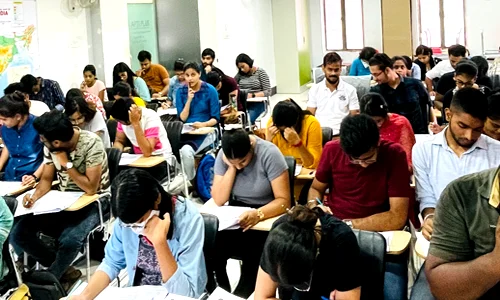



The proposed Jan Vishwas Siddhant seeks to replace Licence Raj with a trust-based regulatory model. Building on the Jan Vishwas Act, 2023, it promotes self-registration, risk-based inspections, decriminalisation of minor offences and a single digital legal portal. The reform aims to cut compliance burdens, boost ease of doing business, spur innovation and support faster economic growth toward a Viksit Bharat.
Click to View MoreIndian federalism is competitive, with states vying for investment through reforms encouraged by NITI Aayog indices. This boosts innovation but risks regional inequality and unsustainable incentives. A balanced cooperative-competitive model is needed to pair healthy rivalry with equitable, sustainable national development.
Click to View MoreIndia aims to become a $30 trillion economy in the next 25 years, driven by sustained GDP growth, strategic government policies, and long-term planning. While past growth trends and currency factors make this projection plausible, challenges such as slowing growth rates, inflation, and infrastructure gaps remain. Achieving this goal will require multi-dimensional efforts in trade, investment, technology, and human capital development, positioning India as a major global economic power by 2050.
Click to View MoreIndia’s public debt, currently around 57% of GDP, has been rising due to persistent fiscal deficits, growing welfare and infrastructure spending, and higher interest costs. High debt limits fiscal flexibility, increases taxpayer burden, and can slow economic growth. The government is addressing this through fiscal consolidation, tax reforms, optimized expenditure, and debt management strategies, aiming for a sustainable debt-to-GDP ratio of 50% by FY31 while supporting economic growth.
Click to View More
The government has reduced customs duties on gold imports to lower gold prices, curb smuggling, and boost official trade. While these measures helped reduce illegal imports and bring some price relief, gold prices remain high due to global economic factors, currency depreciation, and strong demand. Moving forward, further duty cuts, better regulation of digital gold, strengthening anti-smuggling efforts, and revitalizing gold monetisation schemes are recommended to stabilize prices.
Click to View More
Trickle-down economics is a theory that suggests benefits given to the rich and businesses—like tax cuts and incentives—will eventually reach the poor through job creation and economic growth. In India, this approach gained importance after the 1991 liberalization, leading to higher GDP but also rising inequality. While economic reforms boosted investment and infrastructure, wealth concentration limited its impact on lower-income groups. To ensure balanced growth, India now focuses on combining market-driven policies with welfare and inclusion measures such as MGNREGA, PM-KISAN, and digital empowerment initiatives.
Click to View MoreIndia's FDI landscape is facing challenges due to a recent plunge in net FDI, driven by rising outward investment and profit repatriation. To attract and retain high-quality foreign capital, India needs a stable policy environment, enhanced infrastructure, and strategic reforms.
Click to View MoreThe 56th GST Council meeting approved a simplified two-tier tax structure, scrapping old slabs, to make goods and services more affordable. The "Next-Generation GST Reforms" aim to boost consumption, support key sectors, and streamline the tax system for a more transparent Indian economy.
Click to View More
© 2025 iasgyan. All right reserved